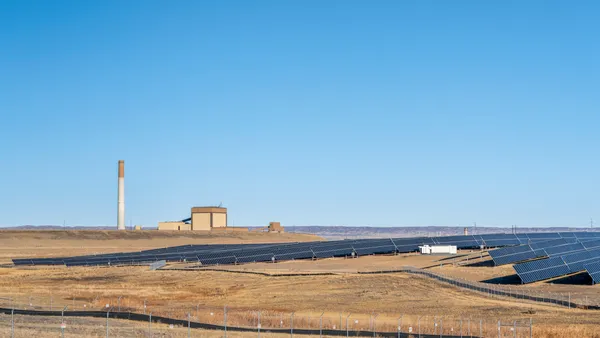Electric utilities represent a $910 billion industry and are essential to the lives of hundreds of millions of Americans. But for the industry to remain healthy it will need both state and federal energy policies to evolve to reflect changing technologies and challenges, according to top leadership the nation's trade group for investor owned utilities
That message was as the upshot of the Wall Street Briefing from the Edison Electric Institute (EEI), where the powerful trade group sketched out a broad look at how the industry stands and many of the challenges it faces. But critics say the group's goals run contrary to what is best for consumers, and they describe an industry hoping ratepayers will wind up footing the bill for risky investments while keeping them captive to traditional power providers.
According to EEI President Thomas Kuhn the industry invests more than $90 billion annually, to transition to a cleaner generating fleet and to enhance the electric grid.
“The grid itself is an amazing technology that drives innovation — and powers possibilities,” he said.
Kuhn laid out the industry's 2015 agenda, which he said includes ensuring that policies related to distributed generation and the evolving distribution system are transparent, avoid cost shifting, and
recognize the value of the grid.
They must also “address fixed-cost recovery, including rate alternatives that reform net energy metering,” he said.
The solar debate
All across the country, state regulators are looking at issues related to net metering and distributed generation. In Hawaii, state regulators had to step in and direct Hawaiian Electric Co. to continue with solar interconnections, and the utility announced late last year an end to its retail-rate net metering program. In Arizona, Tucson Electric in Arizona has proposed lowering the rates it would pay consumers, and Arizona Public Service and Salt River Project have proposed higher fees. In Wisconsin, the state's utilities have also hiked fixed charges for solar owners, and limits on the size of rooftop systems are currently being challenged in the courts.
Critics of the industry say utilities are grasping to hold onto old models, struggling to remain the traditional energy provider rather than backing additional options for consumers. Utilities counter that distributed generation taxes the grid and rooftop solar is far more expensive than other forms of energy.
The Institute for Energy Economics and Financial Analysis said EEI's briefing revealed a “cynical” industry which is increasingly open about its priorities and struggles with consumers.
IEEFA Fellow Cathy Kunkel called the industry's opposition to net metering a “dark strategy,” and alleged “every utility that owns conventional power plants — whether regulated or deregulated — has a financial incentive to oppose competition from rooftop solar.”
But EEI officials say that's not so – only that regulators must ensure all resources are treated equitably, and consumers without solar don't wind up subsidizing those who do have panels.
“I’d like to correct the pervasive misperception that our industry is working to stop rooftop solar. Quite the opposite,” said David Owens, EEI executive vice president of business operations and regulatory affairs.
According to Owens, the industry believes rooftop and community solar can be attractive for some consumers, and said utilities are actively looking at ways the systems can enhance the grid and offer customers cleaner options.
But that said, Owens all added that residential rooftop solar is “the most expensive form of electricity
generation.” By some estimates, it cost up to $3.60/watt last year to produce power using rooftop solar – compared with commercial solar at $2.27/watt and utility-scale at just $1.88/watt.
“It is also important to remember that rooftop solar is being subsidized through extensive federal and state tax credits and other incentives,” Owens said. “This includes state net energy metering policies
that were approved to encourage the introduction of these systems and technologies when they first came to market years ago, and have since outlived their intended use.”
Current state net energy metering policies that compensate at the retail price for electricity sales to the utility “are outdated and need to be updated to align with today’s technology and the ongoing transformation of the grid,” Owens said.
Shifting the risk: Increasing regulated generation
Regulated utilities have a reputation for being safe investments, and EEI notes that the industry’s credit quality rose to a BBB+ average on the S&P scale, after remaining unchanged since the early 2000s. And 87% of the ratings outlooks are currently stable or positive.
A part of that is the industry's push to return generation to regulated utilities, helping ensure profits from plans which may be older and unable to compete with newer generation, or which are facing competition from efficiency and distributed generation. EEI Vice President of Energy Supply and Finance Richard McMahon Jr. said that between 2002 and 2013 the industry has moved from a balance sheet that was roughly 60% regulated to one that’s closer to 75% regulated.
That's a marked change from the excitement of deregulation a decade and a half ago. Then, a number of regulated utilities invested heavily in unregulated subsidiaries with the hope of high returns. But when the wave of deregulation sputtered, load growth stalled, and the financial crisis hit, a number of utilities made the decision to go back to their core competancies — the regulated business.
“It is widely understood that since the early 2000s electric utilities have been renewing their
focus on the customer and business strategies that align with state regulators,” McMahon said. “This is especially important as our capital investment levels have risen dramatically.”
But what EEI sees as “aligning” focus, others see as shifting the risk onto consumers. IEEFA's Kunkel gives a couple of examples, noting that Exelon has been growing regulated operations and FirstEnergy has worked to transfer plants to regulated subsidiaries.
Kunkel called it a “bald-faced ploy to make sure [the utility industry's] profits remain intact.”
Grid investment
The electric utility industry was expected to spend more than $100 billion last year, with a focus on modernizing the grid. Based on an analysis EEI performed last fall, the industry expects transmission was about 20% of that, up from 17% of expenses the year before. Distribution made up 22%, up from 21% in 2013.
“Spending in both of these categories is expected to steadily increase in relative importance over the next few years,” McMahon said.
Looking specifically at transmission, EEI’s projections show investments will total $58 billion over the next three years, allowing utilities to serve growing loads, connect new conventional and renewable generation resources, and increase market efficiency.
But the first installment of the Department of Energy's Quadrennial Energy Review looks at transmission, storage and distribution, and found distributed generation and efficiency could be slowing the need for that investment. “Recent cancellations of transmission projects due to lower demand suggests that there is a connection,” the report found.
In one 20-year study, aggressive demand-side policies resulted in a 36% transmission capital cost reduction, along with substantial carbon reductions.
McMahon acknowledged “the industry continues to face the challenge of an ongoing and projected slow growth in electricity demand.” Although demand rose in 2014, it remained below its 2011 level.
EEI believes some of that will be alleviated as the economy improves, and McMahon said “regardless of the short-run sales outlook, electric utilities are growing earnings by investing in the most attractive opportunities.”
Republican Congress could help on tax issues
The industry has several policy focuses this year, including expanding grid security, ensuring that policies related to distributed generation and the evolving distribution system are transparent and avoid cost shifting,and supporting comprehensive tax reform that would lower rates and simplify the code. And of course, the group is preparing to lobby with regards to the U.S. Environmental Protection Agency's coming Clean Power Plan regulations, once they are finalized in mid summer.
EEI will advocate to maintain the federal income tax deduction for interest expense, keep dividend tax rates low, and addressing excess deferred taxes, according to Brian Wolff, executive vice president of public policy and external affairs.
"With Republicans now controlling Congress, we fully expect the tax reform debate to intensify," Wolff said. "While recent comments from congressional leadership and Administration officials lend to the idea that tax reform is within reach, we believe that real tax reform is still a few years away."























